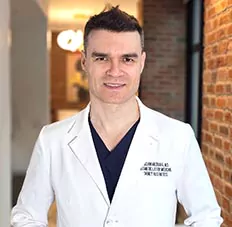Which minimally invasive facial rejuvenation treatment is right for you?
Facial rejuvenation is a common goal amongst both men and women in their mid to late twenties and all ages above. There are a variety of procedures to choose from, leaving many of us wondering where to start and how to choose the right treatment. As an average 32-year-old female, I’ve been asking myself the same questions and decided to dive in and do some research on how to maintain my youthful appearance and how to eliminate the already existing signs of aging on my face. While I, fortunately, do not have any significant signs of aging, such as deep wrinkles or severe sagginess around my jawline, I have noticed an increase in under-eye hollowness and even some mild laxity in my face, particularly in my midface and around my jawline, that never used to be there. After doing some personal research and consulting with several dermatologists and plastic surgeons specializing in minimally invasive procedures, I found that the primary (non-surgical) medical methods used for facial rejuvenation include Botox and Juvederm dermal fillers, collagen-stimulating treatments using thermal energy, and PDO threads. Below is a list of all of the above, how they work, and what they are used for.
Botox and Dermal Fillers
Botox and dermal fillers are both injectable and often go hand in hand, though the two are very different from one another in terms of their purposes and functions.
Botox is a neurotoxin used to eliminate, reduce, and prevent the formation of wrinkles. When injected into a given muscle in the face, it causes temporary muscle paralysis or relaxation by blocking the release of acetylcholine, reducing the muscle contractions and facial expressions that would otherwise lead to the formation of wrinkles, such as raising the eyebrows, frowning, or smiling. While Botox is the best-known neurotoxin, there are many other toxins on the market that, based on scientific studies, differ in chemical composition, yet serve the same purpose and accomplish the same results as Botox. The most commonly used neurotoxins in the U.S. include Botox, Dysport, Xeomin, and Jeuveau.
Dermal fillers date back to the 1960’s, though medical technology has advanced from the now less common silicone injections to hyaluronic acid (HA) based fillers. HA can be used in various regions of the face and body to add volume where it is needed most.
One of my primary concerns was the dark circles underneath my eyes, which often develop with age. As we age, we lose facial fat and volume, making us appear hollow, gaunt, and old.
Under-eye circles are rarely due to discoloration, and instead, due to facial fat and volume loss, casting a shadow that appears as a “dark circle” beneath the eyes. To eliminate dark circles, under-eye fillers can be injected to replace this lost volume, resulting in a fresher and more rejuvenated appearance. While there are several types of dermal fillers, HA fillers are primarily used for facial rejuvenation, under the eyes, in the cheeks, lips, nasolabial folds, and a variety of other areas.
Recap:
- Botox is a neurotoxin and muscle relaxant that is injected into facial muscles to restrict muscle contractions that would otherwise lead to the formation of wrinkles predominantly in the forehead, between the eyebrows, and around the eyes. It can be used to eliminate already existing lines and wrinkles, and as a preventative measure to stop them from forming in the first place. Other neurotoxins that can be used interchangeably with Botox include Dysport, Xeomin, and Jeuveau.
- Dermal fillers, often hyaluronic acid-based, are used to replace lost volume in various regions of the face, including the under eye fillers, cheek fillers, nasolabial fold fillers, lip fillers, temples, and forehead. They can also be used for facial contouring along the bridge of the nose and around the jawline and chin, where beginning signs of aging and lax skin often reduce the natural chiseled contour of the face.
Thermal Energy and Collagen Stimulation
Over the past two decades, advanced medical technology has allowed for the development of a variety of minimally invasive tools to tighten, firm, and improve the texture and overall quality of one’s skin, utilizing the power of heat energy. In 2001, the first RF (radiofrequency) device was born to treat periorbital rhytids and wrinkles. Medical experts found that applying controlled pulses of heat to various layers of the skin using microneedling and fractional lasers causes micro-damage to the cells, triggering the body’s natural healing response by stimulating collagen production in the treated area. Because collagen works as a building block for our skin, keeping it strong and firm, this results in a tightening and lifting effect, as well as improved skin texture.
As we age, our epidermis often becomes dryer, wrinklier, and saggier, due to the damaging effects of sun exposure, the inevitable effects of gravity, and most of all the gradual loss of collagen and skin laxity. By consistently using collagen-stimulating thermal energy in the form of microneedling and lasers, you can keep your collagen levels at a maximum, to tighten and firm already lax skin, or help prevent it from becoming loose in the first place.
Thermal tightening can come in many forms, two of the most popular ones being Secret RF microneedling and non-ablative Fraxel laser treatments. As the names suggest, Secret RF is a form of microneedling that uses radiofrequency energy to target deeper layers of the dermis, while Fraxel is a laser treatment which targets more superficial dermal layers.
While this may sound painful, most providers will apply a topical numbing cream beforehand, making them fairly tolerable for most patients, according to experts in the field.
Recap:
- Thermal energy can be used in the form of microneedling and lasers to cause controlled damage to the dermal layers, resulting in intense collagen production and ultimately improved skin texture, quality, and youthfulness.
- Secret RF is a minimally invasive cosmetic procedure utilizing radiofrequency thermal energy that is delivered to the SMAS layer of the skin, using a handheld mechanical device equipped with several tiny needles. The micro-damage caused to the dermal cells by the heat and punctures of the needles, triggers the body’s natural healing response, producing loads of collagen which in turn, tightens, firms, and smoothes the skin.
- Fraxel is a minimally invasive laser treatment that stimulates collagen production in the areas treated using intense laser pulses causing controlled thermal damage to superficial dermal layers. Fraxel is used to tighten, lift, and firm the skin, and to reduce the appearance of, or eliminate acne scarring, uneven skin texture, crepiness and sun damage.
PDO threads
PDO threads started becoming popular in South Korea and Europe over the past decade and have made their way to the United States in recent years, though they are still considered fairly new in the world of cosmetic medicine. PDO (polydioxanone) threads are biodegradable non synthetic polymers that are used to lift sagging skin in various regions of the face and neck. The threads are barbed, which allows them to stay in place and keep the skin in place once they are inserted into the dermis and pulled upward for a nonsurgical facelift. PDO threads are not only designed for sagginess and turkey neck. In fact, they can be used for the sole purpose of strengthening the skin by being placed without the additional step of lifting the treated area, as the threads leave traces of collagen behind once they dissolve over the course of 2 – 3 months. Collagen serves as a building block for our skin, keeping it tight and supple. As we become older our bodies produce less collagen, which is one of the primary contributing factors to the development of loose skin.
Recap:
- Barbed PDO threads are inserted into the skin and pulled upward along with the skin for a nonsurgical facelift in the lower face, midface, neck, jawline, and forehead, or for the sole purpose of increasing collagen levels in given areas of the face.
- As the threads dissolve over the course of 2 – 3 months, they leave behind a trace of collagen, leaving you with tighter, firmer, and stronger skin.
- PDO thread lifts do not replace surgical facelifts, though they are great options for people looking to lift mild to moderate laxity.
Which option is right for you?
Finding the right treatment for your aesthetic goals can be challenging. Ultimately, the best way to know for sure is to consult with a board certified dermatologist or cosmetic surgeon with experience in all of the above. However, based on my research and conversations with medical professionals in the field, here is what I’ve gathered:
- If you are looking to reduce fine lines and wrinkles in your face, neurotoxins are a go-to. Deeper wrinkles may need to be addressed using dermal fillers, and some doctors may recommend combining Botox with bi-annual collagen stimulating RF or laser resurfacing for optimal results.
- If you want to address volume loss, such as dark circles under the eyes, hollowness in the midface, or nasolabial folds, dermal fillers are the way to go. Dermal fillers are the only solution to replacing lost volume and come in many consistencies and formulations to suit various regions of the face.
- If you are unhappy with the overall quality of your skin, including uneven skin texture, acne scarring, lines and wrinkles, crepiness, or pigmentation spots, your doctor will likely recommend RF microneedling, Fraxel, or a combination of the two.
Always do your research on providers beforehand to make sure that you are getting the appropriate treatment for your desired outcome and to ensure that you go with an experienced board certified medical professional at Skinly Aesthetics.
 info@skinlyaesthetics.com
info@skinlyaesthetics.com  212-774-4264
212-774-4264 

